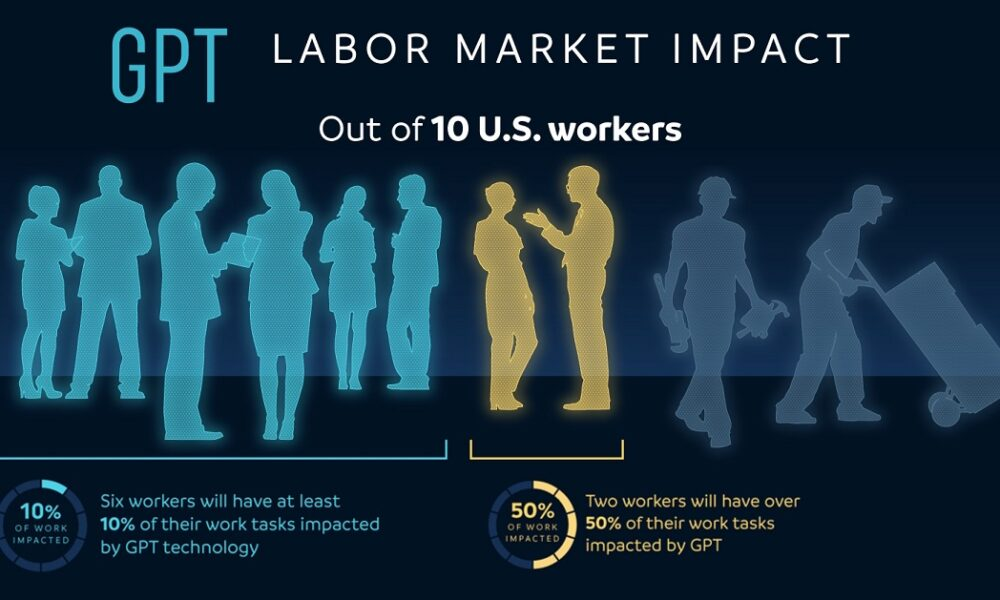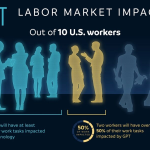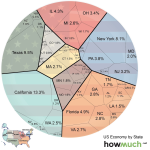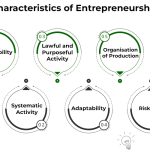The impact of AI on the labor market is already being felt across various industries, igniting intense discussions about the future of work with AI. A recent study highlights significant trends in occupational shifts, revealing that technological disruption jobs are not only evolving but also transforming the skills required for employment. As AI continues to set the pace of progress, workers may find themselves experiencing occupational churn, a phenomenon illustrating the rapid changes happening within job categories. Experts suggest these AI job market trends indicate a movement towards higher-skilled positions, leaving behind lower-paying service roles that once dominated the landscape. It’s clear that the ongoing evolution of the AI workforce changes is reshaping career paths and calling for workers to adapt to an increasingly automated environment.
The influence of artificial intelligence on employment dynamics is catalyzing a paradigm shift in the workforce, compelling both businesses and employees to rethink their roles. As markets evolve, we are witnessing a transformation of job classifications resulting from technological advancements. This ongoing technological disruption is driving the demand for highly skilled personnel while simultaneously diminishing opportunities in lower-wage sectors. Understanding these rapidly changing job market landscapes is essential for assessing the future of work with sophisticated machinery and software at the helm. As these shifts unfold, the emerging occupational patterns will dictate not only the types of jobs available but also the skills necessary to thrive in this new economic environment.
The Changing Face of Employment: AI’s Role in Labor Market Dynamics
As artificial intelligence (AI) continues to evolve, its influence on the labor market becomes more pronounced. The research conducted by economists David Deming and Lawrence H. Summers indicates that technology, particularly AI, is reshaping the job landscape in profound ways. This shift can lead to increased occupational churn, with some professions diminishing while others emerge or transform, reflecting AI’s dual nature as both a tool for enhancement and a source of disruption in job sectors.
One significant finding from the study is the shift from traditional roles to positions demanding high levels of skill and specialization. The emergence of high-paying, AI-enhanced jobs has started to redefine the labor market, moving away from job polarization that previously characterized economic instability. As businesses ramp up their investment in AI technologies, the demand for roles in science, technology, engineering, and mathematics (STEM) fields has surged, highlighting a clear trend towards a workforce increasingly dominated by technological expertise.
Understanding Occupational Churn: A Historic Perspective
Occupational churn, defined as the rate at which jobs change in a given market, provides valuable insights into the ongoing transformations within the labor landscape. Historical analysis over the past century reveals periods of both stability and volatility in the job market, particularly as influenced by technological breakthroughs. By assessing the share of various professions, researchers have identified distinct patterns that indicate how innovations, especially in AI, lead to considerable shifts in employee roles and job availability.
The study’s metrics illustrate that while historical occurrences of job displacement led to fears of mass unemployment, the stabilization seen from 1990 to 2017 was not as dire as many had anticipated. However, the recent findings illuminate a newer form of occupational churn, where high-tech job markets expand while lower-wage jobs diminish in number. As seen during the pandemic, many positions have not only been lost but have undergone considerable transformation, necessitating a reevaluation of skill sets and job qualifications for future employment.
AI Job Market Trends: Analyzing Future Work Landscapes
Evaluating current job market trends amidst the rise of AI technologies reveals critical insights into the future of work. As AI continues to penetrate various industries, it introduces significant shifts in job requirements, professional expectations, and overall employment structures. The ongoing research by Deming and Summers shows a marked increase in STEM job participation—ultimately projected to account for a larger segment of the employment spectrum as AI adoption progresses.
Moreover, this trend suggests that while certain jobs may decline due to AI displacement, new job categories will emerge to take their place. The inclination towards technological proficiency implies that future workers might be required to adapt rapidly, learning new skills to meet evolving job descriptions that increasingly involve collaboration with AI technologies, thus marking a shift in the competencies demanded across industries.
Technological Disruption and Its Connection to Job Polarization
Technological disruption is intricately linked to job polarization, a phenomenon where employment growth occurs at the low and high ends of the wage spectrum. Citing findings from the paper, the earlier pattern of job polarization has shifted, giving way to a more favorable climate for high-skilled positions as AI technology proliferates. This evolution suggests that not only will low-paying jobs decrease, but a new wave of employment opportunities will emerge that requires advanced technological capabilities.
As industries evolve, the labor market must adapt to these changes. This shift necessitates a proactive response from both educational institutions and workers to prepare for the demands of tomorrow’s job market. The significant role of AI in driving this transformation cannot be underestimated, as the workforce gears up for an era where technology and human capability must work in synergy to thrive in an increasingly automated world.
The Future of Work with AI: Opportunities and Challenges
The future of work is poised at a pivotal juncture, influenced greatly by advancements in artificial intelligence. As companies integrate AI into their operations, they face both exciting opportunities and daunting challenges. Firms are anticipating a demand for enhanced efficiency and productivity, leading to potential increases in competitive advantage. However, this shift also raises questions about job security, as functions traditionally performed by humans become automated.
Furthermore, the rapid incorporation of AI into workflows emphasizes the importance of continuous learning and adaptation for workers. Individuals must equip themselves with the necessary tools to thrive alongside AI systems, fostering a culture of learning that can help mitigate potential job displacement. Organizations that prioritize employee training and development will likely have a competitive edge in harnessing AI technology, thus ensuring both business success and workforce stability.
Adapting to AI: Training and Skills Development in the Labor Market
As the influence of AI expands, the need for robust training and skill development becomes paramount for today’s workforce. Workers across all professions must engage in lifelong learning strategies to remain relevant in an ever-evolving job market. The study highlights how firms are investing in advanced technologies and the necessity for employees to not only adapt but also excel in using these innovations. This focus on skills training enhances the labor market’s resilience against potential disruptions caused by AI.
Organizations are recognizing that equipping employees with skills tailored to emerging technologies is crucial for cultivating a future-ready workforce. By fostering environments centered around upskilling and reskilling, companies can address skill gaps highlighted in research findings while also encouraging employee loyalty and job satisfaction. This shift toward professional development is a communal responsibility among employers, educational institutions, and government entities to create a robust framework for embracing AI’s future.
The Impact of AI on Labor Market Stability
The impact of AI on labor market stability is a subject of considerable debate among economists and labor experts. With AI technologies poised to design, execute, and optimize tasks previously performed by humans, the worry arises about potential displacement and the overall safety of job markets. Nevertheless, Deming and Summers’ findings indicate a nuanced landscape where the stability of job markets may indeed adapt alongside technological advancements rather than simply erode.
While historical patterns showed variability in job availability, the latest data suggests an unexpected resilience and adaptability among labor markets in response to AI innovations. The emergence of new roles and the increasing importance of high-skill positions signal a shift towards a knowledge-based economy that may ultimately foster greater employment opportunities, albeit in different capacities than traditionally seen. This requires a rethinking of workforce strategies, focusing on the need for continuous innovation and adaptation to ensure labor market stability.
Exploring E-commerce Growth Amidst Retail Job Declines
Amidst the decline of retail jobs attributed to technological disruptions, e-commerce has risen as a robust sector reflecting the changing consumer habits driven by AI technologies. The transition from physical shopping to online retail has accelerated, especially during circumstances such as a pandemic, transforming the retail landscape significantly. As a result, companies are shifting their focus towards enhancing online platforms while reducing their reliance on traditional sales roles.
The declining percentage of retail jobs coupled with the increase in e-commerce illustrates how technological advancements redefine the employment paradigm. Businesses that adapt to these shifts must prioritize investment in technology, ensuring their workforce is prepared to meet the demands of a digital marketplace reliant on predictive AI capabilities. As retail jobs continue to decline, the evolution of e-commerce signals both challenges and opportunities for the future of the retail labor market.
Navigating Automation Anxiety: Embracing the New Normal
Automation anxiety, characterized by fears over job displacement due to technological advancements, has been a prevalent concern among workers facing the potential impacts of AI. The findings from the Harvard study reaffirm that anxiety is rooted in the fear that machines will replace human labor, yet the longer-term outlook presents a more balanced perspective. As businesses adopt AI to enhance productivity, they also create new employment opportunities that require a different skill set, thus reshaping the need for traditional roles rather than eliminating them.
This ongoing transition emphasizes the importance of adaptability and resilience within the workforce. Workers are encouraged to view AI not just as a threat but as an opportunity to enhance productivity and creativity in their roles. By fostering a mindset of innovation and evolution, both employees and employers are better positioned to navigate the uncertainties of the labor market, embracing the dynamic changes that accompany the rise of AI technologies.
Frequently Asked Questions
How is AI impacting the labor market today?
AI is significantly impacting the labor market by accelerating occupational churn and changing job dynamics. Recent studies reveal that AI is causing a shift in job distribution, with a decline in low-paying, less skilled positions, while increasing demand for high-skilled STEM jobs. This trend suggests that workers will need to adapt to new technologies to remain competitive in the evolving job market.
What are the emerging trends in AI job market related to labor market changes?
Research indicates several key trends driven by AI: the decline of job polarization, an increase in high-paying STEM jobs, a stagnation in low-paying service sector jobs, and a significant drop in retail sales jobs. These trends highlight a structural shift in the labor market, focusing on advanced technology roles and diminishing the need for certain traditional jobs.
What evidence suggests AI will cause more occupational churn in the workforce?
Historical data spanning over 100 years shows that AI is contributing to increased occupational churn, especially since 2019. The analysis indicates that advancements in AI are restructuring industries and job roles, leading to volatility in job availability and creating a demand for higher skill levels among workers.
Can AI lead to significant disruptions in traditional jobs?
Yes, AI is likely to lead to significant disruptions in traditional jobs. As seen during the COVID-19 pandemic, sectors like retail experienced drastic reductions in workforce demands due to increased adoption of online shopping fueled by AI. This shift not only changes job roles but also transforms how consumers interact with services.
What should workers do to prepare for the future of work with AI?
To prepare for the future of work influenced by AI, workers should enhance their skill sets, particularly in STEM fields and technology-related areas. Continuous learning and adaptability are crucial as AI evolves, demanding more sophisticated capabilities from the workforce to meet employer expectations.
How does AI investment change job market trends?
Investment in AI is reshaping job market trends by increasing the demand for technical talent and altering job distribution. As companies invest more in advanced technologies, there’s a noticeable shift towards roles that require higher education and specialized skills, leading to the growth of high-paying jobs and a decrease in low-skilled positions.
What roles are likely to decline due to AI’s impact on the labor market?
Roles that are likely to decline due to AI’s influence include low-paying service jobs and retail positions. The analysis showed that retail sales jobs decreased from 7.5% to 5.7% of the job market from 2013 to 2023, indicating a significant shift towards automation and e-commerce facilitated by AI advancements.
Is automation through AI creating new job opportunities?
Yes, automation through AI is creating new job opportunities, particularly in the STEM fields. As companies strive to innovate and improve efficiency, they are hiring more software developers, data analysts, and technical specialists, reflecting a transformation in the types of jobs available in the labor market.
How does AI influence wage distribution in the labor market?
AI influences wage distribution by contributing to a shift towards high-paying jobs that require advanced skills and education. Recent trends indicate a decline in low-wage job growth while favoring positions with higher compensation, emphasizing the need for workers to acquire relevant skills to access these opportunities.
What long-term effects could AI have on knowledge workers in various sectors?
Long-term effects of AI on knowledge workers may include heightened productivity demands and a redefined skill set requirement. As companies leverage AI technologies, they will likely expect faster output from knowledge workers, which could reshape job expectations and performance metrics in sectors like finance and management.
| Key Points | Details |
|---|---|
| Technological Disruption | AI is changing the labor market significantly, with historical analysis showing fluctuations over the last century. |
| Occupational Churn | A metric shows a slowdown in disruption until 2019, followed by significant changes due to AI. |
| Job Polarization | Recent trends show a focus on high-paying jobs rather than low-paying ones, marking a shift away from job polarization. |
| STEM Jobs | There has been a resurgence in STEM jobs, rising from 6.5% in 2010 to nearly 10% in 2024. |
| Decline in Low-Paying Jobs | Many low-paying service jobs have stagnated or declined since 2019 due to various factors including AI. |
| Retail Sales Decline | Retail sales jobs saw a sharp decline from 7.5% to 5.7% from 2013 to 2023, influenced by e-commerce and AI. |
Summary
The impact of AI on the labor market is profound and multifaceted. A recent study highlights how AI has not only influenced job dynamics but has also shaped the future workforce. The shift from a balanced distribution of job types to a domination of high-skill, high-paying jobs underscores the transformative nature of AI. As certain roles, particularly in retail and low-paying sectors, decline, there is an evident need for the workforce to adapt and acquire new skills in STEM fields. Ultimately, while AI is creating new opportunities, it is also disrupting traditional job sectors, demanding that individuals prepare for an evolving landscape driven by technology.







